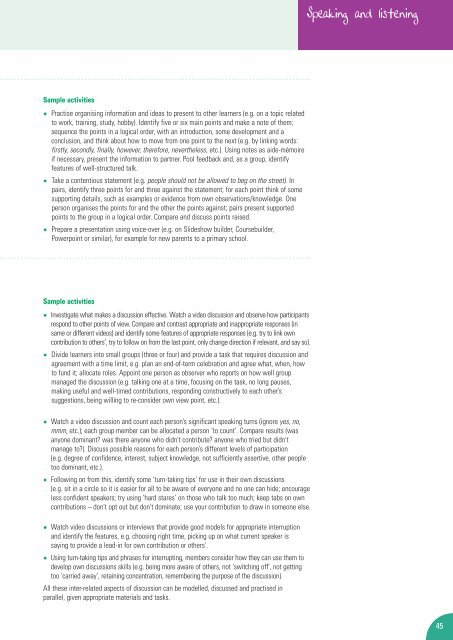Adult Literacy Core Curriculum - Nationally developed Skills for Life ...
Adult Literacy Core Curriculum - Nationally developed Skills for Life ...
Adult Literacy Core Curriculum - Nationally developed Skills for Life ...
You also want an ePaper? Increase the reach of your titles
YUMPU automatically turns print PDFs into web optimized ePapers that Google loves.
Sample activities<br />
• Practise organising in<strong>for</strong>mation and ideas to present to other learners (e.g. on a topic related<br />
to work, training, study, hobby). Identify five or six main points and make a note of them;<br />
sequence the points in a logical order, with an introduction, some development and a<br />
conclusion, and think about how to move from one point to the next (e.g. by linking words:<br />
firstly, secondly, finally, however, there<strong>for</strong>e, nevertheless, etc.). Using notes as aide-mémoire<br />
if necessary, present the in<strong>for</strong>mation to partner. Pool feedback and, as a group, identify<br />
features of well-structured talk.<br />
• Take a contentious statement (e.g. people should not be allowed to beg on the street). In<br />
pairs, identify three points <strong>for</strong> and three against the statement; <strong>for</strong> each point think of some<br />
supporting details, such as examples or evidence from own observations/knowledge. One<br />
person organises the points <strong>for</strong> and the other the points against; pairs present supported<br />
points to the group in a logical order. Compare and discuss points raised.<br />
• Prepare a presentation using voice-over (e.g. on Slideshow builder, Coursebuilder,<br />
Powerpoint or similar), <strong>for</strong> example <strong>for</strong> new parents to a primary school.<br />
Sample activities<br />
• Investigate what makes a discussion effective. Watch a video discussion and observe how participants<br />
respond to other points of view. Compare and contrast appropriate and inappropriate responses (in<br />
same or different videos) and identify some features of appropriate responses (e.g. try to link own<br />
contribution to others’, try to follow on from the last point, only change direction if relevant, and say so).<br />
• Divide learners into small groups (three or four) and provide a task that requires discussion and<br />
agreement with a time limit, e.g. plan an end-of-term celebration and agree what, when, how<br />
to fund it; allocate roles. Appoint one person as observer who reports on how well group<br />
managed the discussion (e.g. talking one at a time, focusing on the task, no long pauses,<br />
making useful and well-timed contributions, responding constructively to each other’s<br />
suggestions, being willing to re-consider own view point, etc.).<br />
• Watch a video discussion and count each person’s significant speaking turns (ignore yes, no,<br />
mmm, etc.); each group member can be allocated a person ‘to count’. Compare results (was<br />
anyone dominant? was there anyone who didn’t contribute? anyone who tried but didn’t<br />
manage to?). Discuss possible reasons <strong>for</strong> each person’s different levels of participation<br />
(e.g. degree of confidence, interest, subject knowledge, not sufficiently assertive, other people<br />
too dominant, etc.).<br />
• Following on from this, identify some ‘turn-taking tips’ <strong>for</strong> use in their own discussions<br />
(e.g. sit in a circle so it is easier <strong>for</strong> all to be aware of everyone and no one can hide; encourage<br />
less confident speakers; try using ‘hard stares’ on those who talk too much; keep tabs on own<br />
contributions – don’t opt out but don’t dominate; use your contribution to draw in someone else.<br />
• Watch video discussions or interviews that provide good models <strong>for</strong> appropriate interruption<br />
and identify the features, e.g. choosing right time, picking up on what current speaker is<br />
saying to provide a lead-in <strong>for</strong> own contribution or others’.<br />
• Using turn-taking tips and phrases <strong>for</strong> interrupting, members consider how they can use them to<br />
develop own discussions skills (e.g. being more aware of others, not ‘switching off’, not getting<br />
too ‘carried away’, retaining concentration, remembering the purpose of the discussion).<br />
All these inter-related aspects of discussion can be modelled, discussed and practised in<br />
parallel, given appropriate materials and tasks.<br />
Speaking and listening<br />
45

















